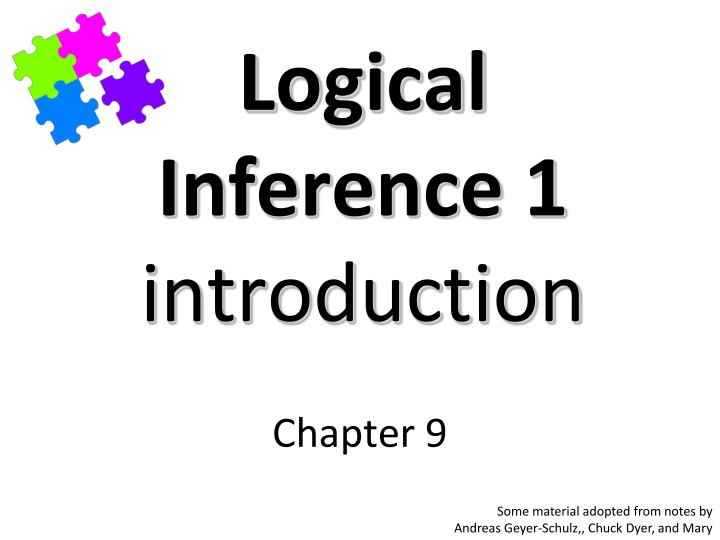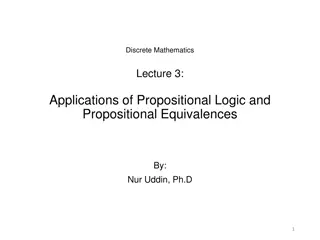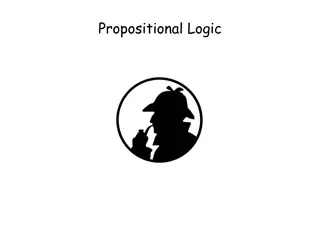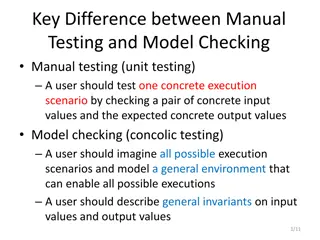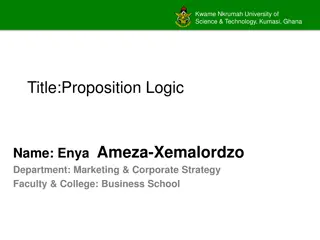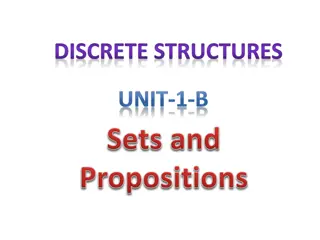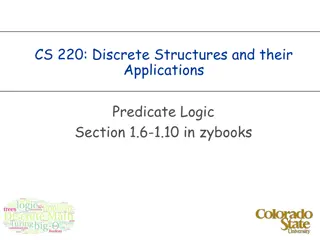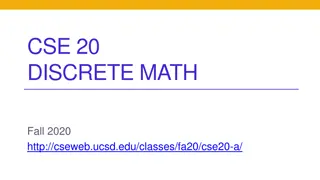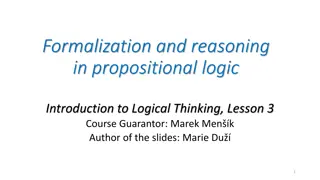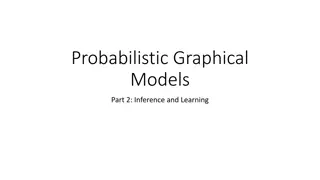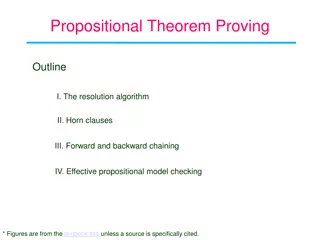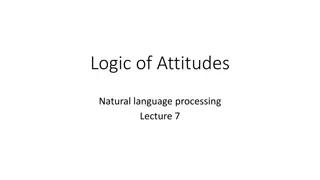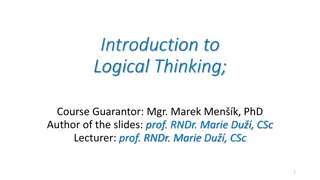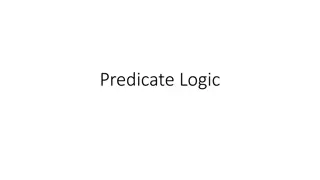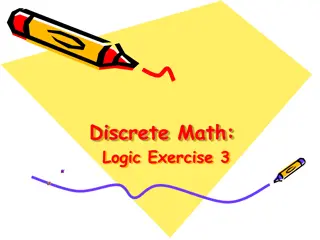Logical Inference: Propositional Logic Model Checking and Efficient Algorithms
Overview of logical inference covering model checking for propositional logic, rule-based reasoning in first-order logic, and efficient PL model checking algorithms like DPLL. The content explores various inference rules, resolution-based reasoning, and techniques for determining entailment between knowledge base and sentences. It also discusses strategies like early termination, pure symbol heuristic, and unit clause heuristic for efficient model checking.
Download Presentation

Please find below an Image/Link to download the presentation.
The content on the website is provided AS IS for your information and personal use only. It may not be sold, licensed, or shared on other websites without obtaining consent from the author.If you encounter any issues during the download, it is possible that the publisher has removed the file from their server.
You are allowed to download the files provided on this website for personal or commercial use, subject to the condition that they are used lawfully. All files are the property of their respective owners.
The content on the website is provided AS IS for your information and personal use only. It may not be sold, licensed, or shared on other websites without obtaining consent from the author.
E N D
Presentation Transcript
Logical Inference 1 introduction Chapter 9 Some material adopted from notes by Andreas Geyer-Schulz,, Chuck Dyer, and Mary Getoor
Overview A: Model checking for propositional logic Rule based reasoning in first-order logic Inference rules and generalized modes ponens Forward chaining Backward chaining Resolution-based reasoning in first-order logic Clausal form Unification Resolution as search Inference wrap up
From Satisfiability to Proof To see if a satisfiable KB entails sentence S, see if KB S is satisfiable If it is not, then the KB entails S If it is, then the KB does not email S This is a refutation proof Consider the KB with (P, P=>Q, ~P=>R) Does the KB it entail Q? R?
KB Does the KB entail Q? P P=>Q ~P=>R P P=>Q ~P => R ~Q P ~P v Q P v R ~Q Q An empty clause represents a contradiction We assume that every sentence in the KB is true. Adding ~Q to the KB yields a contradiction, so ~Q must be false, so Q must be true.
KB Does the KB entail R? P P=>Q ~P=>R P P=>Q ~P => R ~R P ~P v Q P v R ~R Q Q v R P Q Adding ~R to KB does not produce a contradiction after drawing all possible conclusions, so it could be False, so KB doesn t entail R.
Propositional Logic Model checking Given KB, does a sentence S hold? All of the logic variables in S must be in the KB Basically generate and test: Consider models M in which every sentence in the KB is TRUE If M S , then S is provably true If M S, then S is provably false Otherwise ( M1 S M2 S): S is satisfiable but neither provably true or provably false
Efficient PL model checking (1) Davis-Putnam algorithm (DPLL) is generate-and- test model checking with several optimizations: Early termination: short-circuiting of disjunction/conjunction Pure symbol heuristic: symbols appearing only negated or un-negated must be FALSE/TRUE respectively e.g., in [(A B), ( B C), (C A)] A & B are pure, C impure. Make pure symbol literal true: if there s a model for S, making pure symbol true is also a model Unit clause heuristic: Symbols in a clause by itself can immediately be set to TRUE or FALSE
expr parses a string, and returns a logical expression Using the AIMA Code python> python Python ... >>> from logic import * >>> expr('P & P==>Q & ~P==>R') ((P & (P >> Q)) & (~P >> R)) dpll_satisfiable returns a model if satisfiable else False >>> dpll_satisfiable(expr('P & P==>Q & ~P==>R')) {R: True, P: True, Q: True} >>> dpll_satisfiable(expr('P & P==>Q & ~P==>R & ~R')) {R: False, P: True, Q: True} >>> dpll_satisfiable(expr('P & P==>Q & ~P==>R & ~Q')) False >>> The KB entails Q but does not email R
Efficient PL model checking (2) WalkSAT is a local search for satisfiability: Pick a symbol to flip (toggle TRUE/FALSE), either using min-conflicts or choosing randomly or you can use any local or global search algorithm! There are many model checking algorithms and systems See for example, MiniSat International SAT Competition (2003 2016)
>>> kb1 = PropKB() >>> kb1.clauses [] >>> kb1.tell(expr('P==>Q & ~P==>R')) >>> kb1.clauses [(Q | ~P), (R | P)] >>> kb1.ask(expr('Q')) False >>> kb1.tell(expr('P')) >>> kb1.clauses [(Q | ~P), (R | P), P] >>> kb1.ask(expr('Q')) {} >>> kb1.retract(expr('P')) >>> kb1.clauses [(Q | ~P), (R | P)] >>> kb1.ask(expr('Q')) False AIMA KB Class PropKB is a subclass A sentence is converted to CNF and the clauses added The KB does not entail Q After adding P the KB does entail Q Retracting P removes it and the KB no longer entails Q
Reminder: Inference rules for FOL Inference rules for propositional logic apply to FOL as well Modus Ponens, And-Introduction, And-Elimination, New (sound) inference rules for use with quantifiers: Universal elimination Existential introduction Existential elimination Generalized Modus Ponens (GMP)
